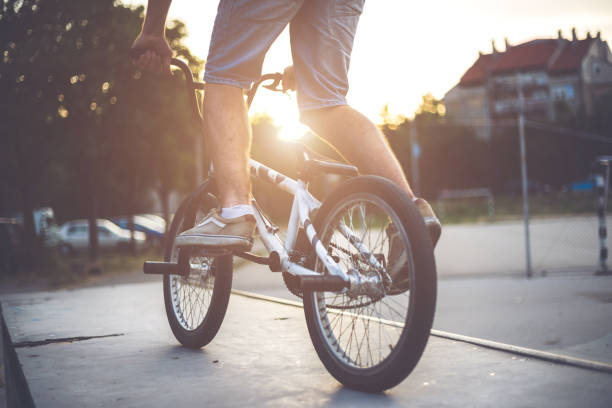Not so long ago, you’d have to solder your own bike from scratch to come up with a bike that is roughly the right size for you. Most of us kids back then grew up using bikes of our older siblings or whatever we could get our hands-on with size being just another trivial thing. Nowadays, you can order a full BMX setup, specifically designed according to your size and style, right out of the box.
Of all the things that matter in choosing a BMX to buy, the size is the most crucial element to get right. Even a centimeter or two can completely alter how the bike feels and fits. It’s all too easy to get crossed up considering different BMX sizes, components, and categories. To help you with that, we have compiled a guideline to help you choose the right BMX size.
Why Size Matters?
After determining your riding style and choosing a model, the size of your BMX should be your first concern. You simply won’t get the most out of your bike if you get the wrong BMX frame size. Either you will lack comfort or efficiency, or both. Here are some potential issues you will encounter if you choose the wrong BMX size:
Lack of control
Getting a wrong size bike will make it harder to maneuver and maintain control and can seriously affect comfort and speed. There are so many unpredictable things that could go wrong in BMX riding. That’s why minimizing the room for error by getting the right size and taking other precautions is an important step to take.
Back pain
Riding a BMX with a wrong size forces you to keep a poor body posture which, in turn, could lead to significant pain in your lower back. This is mainly attributed to the fact that you have to lean forward to reach the handlebars if you have a large frame. The idea is to avoid having to stretch too far or pull your back too much.
Sore wrists and ankles
Riding a bike whose size doesn’t fit you will put too much strain on your wrists and ankles. Frames that are too large or high will force you to bend your body forward and put more pressure on your wrists and sprain your ankles.
BMX Bike Measurements

Before choosing a proper bike size it is crucial to familiarize yourself with standard bike measurements which will help you steer towards the ideal size for your riding needs and body. Therefore, as far as bike size is concerned, there are 3 important factors to consider:
BMX frame size
This is often referred to as the top tube length which helps determine whether the frame is on par with your body. While slight modifications can be made in regards to stem length, handlebars and saddle setback, the correct frame size is where it all starts.
Normally the bike is measured from the head tube to the seat post tube. In this way, you can determine how far or close the handlebars are to you, whether their size can affect your bike handling characteristics and cause discomfort. By default, you’d want enough space for your knees to not get in the way of handlebars. However, this also depends on the height of the rider which we will turn next.
Rider height
This usually involves measuring your stand-over height. Theoretically, your stand over height is the height from the top of the top tube to the ground. Normally, a rider with longer legs would need a longer top tube length and vice versa. For an optimum size, you should clear a few inches between your crotch and the top tube. The clearance between you and the frame will help you avoid any potential injuries and accounts for your overall comfort level and performance. However, taller and shorter riders should choose higher/shorter frames based on their riding style and personal preferences.
Wheel size
In addition to the right top tube length and rider height, there are certain configurations in terms of wheel size as well. Knowing what wheel size works for you best has a major bearing on gauging whether a BMX will meet your needs and fit your riding style or not. While most standard BMX wheels are 20”, shorter riders may use 16 or 18”. Sizes also depend on whether the BMX is used for freestyle stunts or casual riding around the city. Below you will find a geometry chart comprising measurements of wheel sizes based on your height and frame size.
BMX Bike Sizing Chart
If you’re unsure what frame and wheel size accommodates your height and riding style, here’s a rundown of some important numbers that will hopefully help you get the right size for your BMX bike. While we’d always recommend checking manufacturer’s size charts, you can also visit bike stores and consult with a staff member to choose the accurate configurations. Nevertheless, here are some general BMX bike sizing guidelines:
| Rider Height | TopTube Length | Wheel Size |
| 4’0″ | 15-16″ | 16″/18″ |
| 4’0″-4’5” | 16-17″ | 16″/18″ |
| 4’6″-5’0″ | 17-18.5″ | 18″/20″ |
| 5′-5’2″ | 18-19″ | 20″ |
| 5’2″-5’4″ | 18-19.5″ | 20″ |
| 5’4″-5’10″ | 20-20.5″ | 20″ |
| 5’10″ and over | 20.5″-22″ | 20″ |
Normally, you will know right away if a bike is too short or long in the top tube but nothing beats the benefit of taking your BMX for a short test ride. While jotting down the above measurements are helpful in determining your almost perfect BMX size, taking your bike for a spin will give you a better insight into the bike’s comfort level and adds further value to the process.




